I don’t think I make any secret about my compulsions.
What I like to think of as my interests.
My glass collection is a particular pet of mine, and, as most of it is still in storage in various locations, I must confess to missing it.
My daughter Caitriona, who had photographed most of it for a talk I gave to the glass society,very kindly mailed me copies of the photographs she had taken so I now can see my collection once more.
I have already shown you some of these in the piece I did on Absinthe Glass
Here are a few oddities from my collection.
The first piece of glass we inherited from Sile’s grandfather’s house in Edenderry. This far inland is not the place you would expect to find flotsam or even jetsam but these old glass floats must have been salvaged from a beach at some time.
One even has a dribble of water in it.
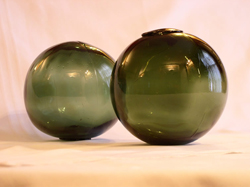
Glass Floats
Our American friends the Fritsches, introduced us to their habit of combing the beach for found glass, it became part of our beach routine on those (not at all rare) days on the beach when the sun didn’t get around to splitting the stones.
This collection, which has only sentimental value, I have always valued for the memories of cold days with the children by the sea.
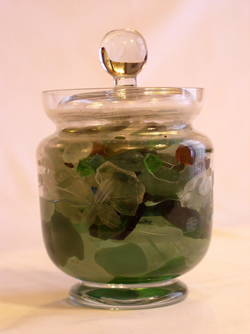
Jar of Found Glass
There was, in the old Granary on the Quay in Waterford, (now Waterford Treasures Museum) an excellent Auction Gallery run by David Harris.
This was a great place for bargains and it was here that, about 20 years ago, for very little money that I bought, this old Cona coffee maker from the 1930’s. The bits in the picture are just some of the various pieces which were in the box I bought.
It all works perfectly.
One just has to fill the round bottomed flask with water and put the coffee in the other container.which fits neatly into it, (the silver base is just a rest)
You then heat the bottom flask and as soon as it boils it forces water into the top container, then the ingenious glass stopper stops the grounds from returning to the bottom flask.
Incredible that it still works perfectly!

Cona Coffee Maker
Like the finding of the Absinthe glasses, it was in a rented house in France that we first came across one of these.But not until we saw it in use in a village house that we realised what it was;
A Wasp Trap.
Something sweet and attractive was placed in the internal reservoir, covered with water and thus the wasp was enticed in and drowned.
They still work better than any of the electronic devices available today.
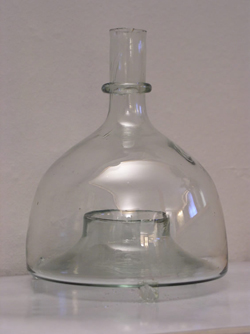
Wasp Trap
This oddment I came across in a Brocante in in Valreas in the north of Provence, I was intrigued but baffled until the proprietor explained that it was a bird feeder.
You fill the container with water then gravity or atmospheric pressure or something (I was never the best at science) just releases as much water into the bowl as the bird drinks. Again ingenious.
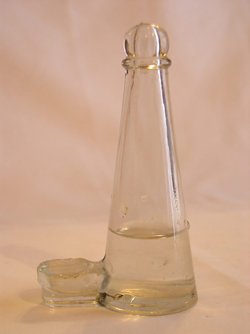
Bird Feeder
I bought this in an old junk shop in Rye in Sussex.
I recognized it for what it was and, because it was so cheap, assumed the shopkeeper didn’t. Of course he knew exactly and said something in the lines of, you wouldn’t be getting this so cheap if the rest of the Epergne was with it.
It is the centrepiece of that wonderful piece of Victorian extravaganza; The Epergne.
In these the Victorians used to create masterpieces of floral arrangements for their dinner parties

Epergne
An intact one looks like this

Intact Epergne (not mine I’m afraid)
Now this piece was a complete mystery to me for many years. I bought it for a few pence in an antique shop in Virginia Co. Cavan about 6 years ago. The shop owner had no idea what it was, and neither did anyone from the Glass Society to whom I showed it. Its only about three inches long.
Just a couple of years ago Kim Mawhinney, curator of glass in the Ulster Museum, finally solved the mystery.
It is, she thinks a Confiseur’s rolling pin, used by the makers of sweets and petit fours to roll out their sugar paste.
Strange that it ended up in Co. Cavan and even more bizarre that it ended up in my hands.
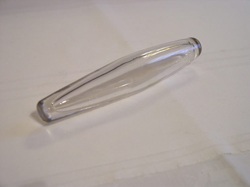
Confiseur’s Rolling Pin
The last two pieces are still a mystery to me.
Both were bought in the UK, the odd bottle with the strange neck in Edinburgh
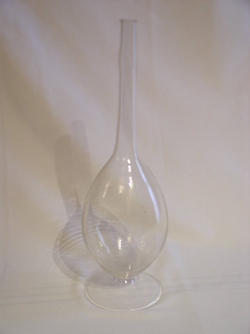
Mystery Flask
The strange cut off glass in Canterbury

Mystery Glass
Various theories have been put forward.
Something scientific for the bottle?
Potpourri for the glass?
Any Suggestions?

Comments
The comments are closed.